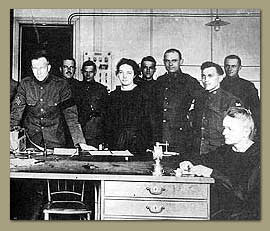Her
radiological services well under way, Curie turned her attention to
establishing a military radiotherapy service. By 1915 it seemed likely
that the Germans could not take Paris. After retrieving the gram of
radium from Bordeaux, Curie began to use a technique pioneered in
Dublin to collect radon--a radioactive gas that radium steadily emits.
Working alone, without protecting herself adequately from the radioactive
vapors, she used an electric pump to collect the gas at 48-hour intervals.
She sealed the radon in thin glass tubes about one centimeter long,
which were delivered to military and civilian hospitals. There doctors
encased the tubes in platinum needles and positioned them directly
within patients' bodies, in the exact spot where the radiation would
most effectively destroy diseased tissue.
“The story of radiology in war offers a striking example
of the unsuspected amplitude that the application of purely
scientific discoveries can take under certain conditions.
X-rays had only a limited usefulness up to the time of the
war...A similar evolution took place in radium therapy, the
medical applications of radiations emitted by the radioelements.”
--Marie Curie, Radiology in War
|
 HOULD SHE HAND OVER her medals to the government? In addition to the contributions to the
war effort that Curie could make as a scientist, she was also an ordinary
citizen. When the government asked people to contribute their gold
and silver, Curie decided to offer her two Nobel medals, along with
all the other medals bestowed on her over the years. The French National
Bank turned down the offer, but Curie did her part by using most of
the Nobel prize money to buy war bonds. HOULD SHE HAND OVER her medals to the government? In addition to the contributions to the
war effort that Curie could make as a scientist, she was also an ordinary
citizen. When the government asked people to contribute their gold
and silver, Curie decided to offer her two Nobel medals, along with
all the other medals bestowed on her over the years. The French National
Bank turned down the offer, but Curie did her part by using most of
the Nobel prize money to buy war bonds. |
|
The war ended on
November 11, 1918, but Curie's war-related work continued for nearly
another whole year. During the spring of 1919 she offered radiology
courses to a group of American soldiers who remained in France while
awaiting passage home. That summer she summarized much of her wartime
work in a book titled Radiology in War. By the fall of 1919
her laboratory at the Radium Institute was finally ready. She would
devote most of the rest of her life to it.
|
 |
| Curie said that these American
officers, who became her students at the Radium Institute in
the spring of 1919, also “studied with much zeal the practical
exercises directed by my daughter.” (Photo ACJC) |
|
� 2000 -
American Institute of Physics
|

